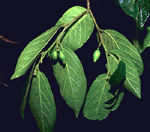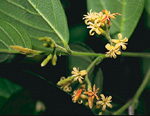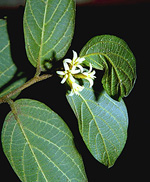 |
This small, tropical family is found in South America, Africa and from India to the Pacific islands and south to eastern Australia. Three species of Alangium occur in Australia, in rainforests in northern New South Wales and eastern Queensland.
Characteristic features of the family Alangiaceae in Australia include: - trees or shrubs with alternate leaves often with domatia on the undersurface
- flowers small, with twisted, reflexed petals when mature
- stamens 4-6, often with hairy filaments
- ovary inferior, with a fleshy disc around the base of the style, developing into a hard, woody drupe
Description
Evergreen trees. Internal secretions not obvious. Plants glabrous or with simple, non-glandular, unicellular hairs. Leaves alternate and spiral, petiolate. Stipules absent. Lamina simple, symmetric or conspicuously asymmetric, lanceolate, ovate, oblanceolate or obovate; base cuneate, rounded, cordate, oblique or rarely attenuate; margins entire; venation pinnate, with the midrib conspicuous, and the tertiary venation reticulate; surfaces not punctate; herbaceous or leathery. Domatia consisting of pits or pockets in the vein angles. Plants with all the flowers bisexual. Inflorescences axillary, consisting of dichasial cymes. Bracts and bracteoles absent. Flowers stalked. Floral disc present; nectaries absent. Perianth regular, of 2 dissimilar whorls, with 8–11 segments. Calyx segments fused, with 4–6 lobes, valvate or open in bud; calyx bell-shaped or tubular; herbaceous. Corolla segments fused, with 4 or 5 lobes, alternating with the calyx lobes, valvate in bud; corolla bell-shaped, white, cream or yellow, papery; lobes ±entire. Fertile stamens 4–8, opposite to the calyx lobes, free or at least partly fused to the corolla, free of the ovary and style, distinct from each other or fused by their filaments into an open or closed tube, all ±equal. Staminal filaments hairy. Anthers basifixed, not versatile, opening inwards by longitudinal slits; 2-celled. Ovary inferior. Carpels 1 (–2), fused; ovary with 1 locule. Style terminal, single, unbranched and the stigma capitate and 3-lobed. Ovule 1, stalked; placentation apical. Fruit a fleshy drupe; the perianth on the maturing fruit deciduous or dry and persistent. Disseminule macro-surface featureless or with straight hairs; micro-surface ±smooth, brown, grey or black, dull. Seeds 1 per fruit. Aril absent. Cotyledons 2. Embryo straight.
(Note: this description has been generated from the coded data compiled for the key. Any errors in the key data will be reflected in the descriptions.)
A treatment of the family Alangiaceae has been published in:
Flora of Australia 22: 11-13.
Australian genera of Alangiaceae (as recognised for the Flora of Australia)
Alangium

|
  |

Alangium villosum (fruits)
Photo: G.Leiper © G.Leiper

Alangium villosum ssp. tomentosum (flowers)
Photo: D.Jones © D.Jones

Alangium villosum ssp. tomentosum (flowers)
Photo: G.Leiper © G.Leiper
|
 |
|